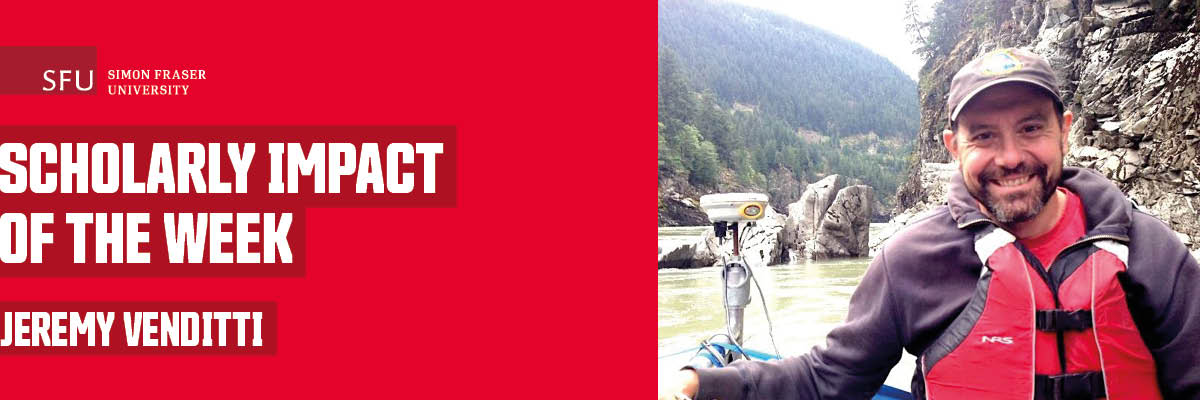
Wind, rain and other forces move vast quantities of sediments across the planet, shaping mountains, riverbeds, farmlands and coasts. Understanding the mechanisms of sediment transport has important applications in numerous contexts—from the way infrastructure is designed to natural hazard mitigation, to pollutant transport and restoration of coasts and river deltas. Understanding geological processes can even help with the study of other Earth-like planets.
Simon Fraser University (SFU) environmental science professor Jeremy Venditti leads interdisciplinary research at SFU’s River Dynamics Laboratory. As a geomorphologist, Venditti’s work focuses on fluid dynamics, sediment transport and bedrock erosion processes in Earth’s largest river systems. He also has a particular interest in natural hazards associated with flooding and the impacts of flooding in a changing climate.
Venditti is a principal investigator on the Salmon and Landslides project at SFU and conducted research on the 2018 Big Bar landslide in British Columbia—work that has captured the attention of national and international media. He was recently interviewed about changing Fraser River sediment for the Tyee.
Venditti has observed that despite decades of research, the variations in bed load transport—the way sediment moves across the Earth’s surface—is still very difficult to predict. His latest study—a collaboration between SFU and MIT—examined the granular dynamics of sediment transported by fluid flows, and showed that grain shape plays an important role in sediment transport rates.
The team developed and tested a model that substantially improves the ability to predict sediment transport, a tool that can aid in better understanding a changing climate, and a changing planet. The paper, Grain shape effects in bed load sediment transport was recently published in Nature.
What was missing from previous models that you were able to add to make more accurate predictions of sediment bed load behaviour?
It has been recognized that grain shape influenced sediment transport since the pioneering work of Albert Shields about 100 years ago. He undertook experiments that revealed the flow condition necessary to begin sediment grain movement by water flows. Most experimental research on sediment transport since then has focused on the movement of spherical particles in laboratories, but natural grains are rarely spheres. We recognized this and decided to explore how different shapes of particles influenced their movement.
How does grain shape affect the way sediment bed load behaves?
In order for grains to roll, slide and tumble along in water and air flows they must rotate out of their initial position among other grains. It is relatively easy for spheres to rotate, but less spherical and more angular grains are harder to move because it is harder for them to rotate out of position. More complex grains in motion appear to have a virtual stickiness that makes it harder for grains to move.
Tell us more about are some of the practical uses for this type of model.
Sediment transport models are used for all kinds of environmental research and engineering. They are used to predict practical things like when a bridge pier or tunnel under a river will be scoured during floods, the conditions under which a restored river or coastline will be stable and unstable, or when dust will be emitted from farmers’ fields. The models are also used for more esoteric pursuits, like exploring the rate at which Earth’s landscape evolves, when gravels used by salmon for spawning and rearing will move, or when sand dunes on the surface of Mars migrate.
What do you find most interesting or exciting about geomorphology and your research field?
Geomorphology is the science of the natural world around us, the scenery we travel the world to explore and the physical habitat for all organisms on earth. I have been fortunate to study geomorphology at a time when it is being used to understand so many important problems including the key linkages between life on earth and landscapes and the evolution of the surface of extraterrestrial planets. I am fascinated by how I can use fundamental physics of processes happening all around us to predict how the Earth and other planetary surfaces evolved through geologic time.
For more: Science of sediment transport key to river conservation & protection: Researchers
SFU's Scholarly Impact of the Week series does not reflect the opinions or viewpoints of the university, but those of the scholars. The timing of articles in the series is chosen weeks or months in advance, based on a published set of criteria. Any correspondence with university or world events at the time of publication is purely coincidental.
For more information, please see SFU's Code of Faculty Ethics and Responsibilities and the statement on academic freedom.